Image processing apparatus, image-taking system, image processing method and image processing program
a processing apparatus and image processing technology, applied in the field of image information processing technology, can solve the problems of large intensity, difficult to suppress unwanted diffract light across the entire visible light region, and difficult to apply to the element which comprises an image-taking optical system such as a camera lens, etc., and achieves the effects of high brightness, difficult visual recognition, and high quality
- Summary
- Abstract
- Description
- Claims
- Application Information
AI Technical Summary
Benefits of technology
Problems solved by technology
Method used
Image
Examples
embodiment 1
[0061]FIG. 4 shows a system block diagram of a digital still camera as an image-taking system which includes an image processing apparatus as Embodiment 1 of this invention. In FIG. 4, arrows with a dotted line indicate the flow of processing instructions and arrows with a solid line indicate the flow of information.
[0062]The digital camera shown in FIG. 4 has an image-taking section 10, a controller 20, an electrical signal processing section 30, and an output image memory 40. Of these, the image-taking section 10 has an image-taking optical system 11 which includes a diffractive optical element which has a diffractive surface, and an image-pickup element 12 which is composed of a photoelectric conversion element such as a CCD sensor or CMOS sensor. The image-taking section 10 forms an image of an object image from the image-taking optical system 11 on a light-receiving surface of the image-pickup element 12, and outputs an electrical signal from the image-pickup element 12.
[0063]T...
embodiment 2
[0123]FIG. 14 shows a system block diagram of a computer as an image processing apparatus as Embodiment 2 of this invention. This computer comprises a CPU (controller) 50 which conducts calculational processing and driving instructions of the computer, an information input interface 60 which is responsible for incorporation of information from outside the computer, a processing instructions input interface 70 which allows the user to input instructions to conduct a predetermined processing into the computer, a hard disk 80 which stores various information and the operating system of the computer, a RAM 90 which temporarily stores information which is necessary when implementing operations in response to an instruction from the CPU 50, and an image display section 100 for displaying information such as an image or a GUI. These are connected to each other by a bus which transfers processing signals and various information.
[0124]This computer incorporates onto the hard disk 80 via the ...
embodiment 3
[0188]FIG. 20 and FIG. 22 show system block diagrams of a digital still camera as an image-taking system which includes an image processing apparatus as Embodiment 3 of this invention. In FIG. 20, arrows with a dotted line indicate the flow of processing instructions and arrows with a solid line indicate the flow of information. In FIG. 20 and FIG. 22, components which are common with Embodiment 1 have been assigned the same symbols as the corresponding components in FIGS. 4 and 6.
[0189]The image-taking system has an optical system 11 which includes a diffractive optical element, an image-taking section 10 which comprises an image-pickup element 12 which is composed by a photoelectric conversion element such as a CCD sensor or CMOS sensor, and a controller (CPU and memory) 20 which issues driving instructions for the overall image-taking system and also stores various information other than image information.
[0190]The image-taking system also has an electrical signal processing sect...
PUM
 Login to View More
Login to View More Abstract
Description
Claims
Application Information
 Login to View More
Login to View More - R&D
- Intellectual Property
- Life Sciences
- Materials
- Tech Scout
- Unparalleled Data Quality
- Higher Quality Content
- 60% Fewer Hallucinations
Browse by: Latest US Patents, China's latest patents, Technical Efficacy Thesaurus, Application Domain, Technology Topic, Popular Technical Reports.
© 2025 PatSnap. All rights reserved.Legal|Privacy policy|Modern Slavery Act Transparency Statement|Sitemap|About US| Contact US: help@patsnap.com



